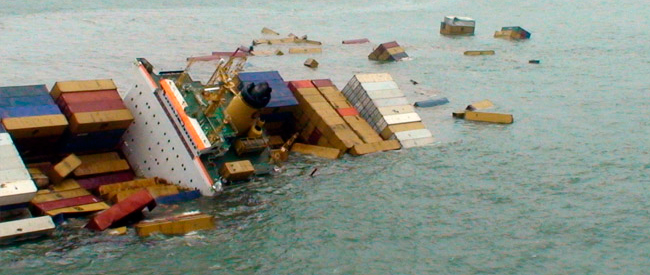Insurance: Possibilities and Limitations
 Trade credit is often extended by carriers (for example: operators such as Hamburg Sud, where I worked for a spell) to regular or high-volume/-value customers. For firms who require frequent shipping, credit provision is one benefit of holding managed accounts with the carrier (other benefits are customer service-related). When cash-flow constraints limit the availability of funds, credit facilitates business continuity. When the restraint is lifted (when the funds from a major sale are received, for example), the firm can then repay the credit extended by the borrower. In the case of shipping, firms may experience demand spikes. To meet their orders, firms might have to increase capacity. Any expansion of plant will come at high cost. If overseas orders are particularly voluminous and sudden, the transportation budget that normally covers shipping costs quite adequately will probably be insufficient. To deliver however, the firm will need to ship. Offering favourable credit terms provides firms with much needed flexibility. Carriers who can extend trade credit are especially attractive to small and medium-sized export-oriented manufacturers. The normative assumption is that the customer will repay the carrier when financial stability is re-established.
Trade credit is often extended by carriers (for example: operators such as Hamburg Sud, where I worked for a spell) to regular or high-volume/-value customers. For firms who require frequent shipping, credit provision is one benefit of holding managed accounts with the carrier (other benefits are customer service-related). When cash-flow constraints limit the availability of funds, credit facilitates business continuity. When the restraint is lifted (when the funds from a major sale are received, for example), the firm can then repay the credit extended by the borrower. In the case of shipping, firms may experience demand spikes. To meet their orders, firms might have to increase capacity. Any expansion of plant will come at high cost. If overseas orders are particularly voluminous and sudden, the transportation budget that normally covers shipping costs quite adequately will probably be insufficient. To deliver however, the firm will need to ship. Offering favourable credit terms provides firms with much needed flexibility. Carriers who can extend trade credit are especially attractive to small and medium-sized export-oriented manufacturers. The normative assumption is that the customer will repay the carrier when financial stability is re-established.
Normally, credit obtained directly from the shipper is simpler to obtain and cheaper to service than credit obtained from a third party, such as a bank. Trade credit rarely inflicts the interest rates and penalties that characterise bank loans. For the carrier too, trade credit is beneficial: provision of trade credit also allows vessels to sail with an economically rational quantity of cargo.
The recovery of payment for shipments carried on trade credit is usually the responsibility of the carrier’s credit control division. If payment recovery becomes unduly arduous and costly, and a significant portion of each vessel’s cargo is carried on credit, the carrier will soon find itself struggling and, perhaps, borrowing to meet its own costs. In such cases, credit insurance will be useful. Insurers can compensate for failed creditors. If debts are permitted to grow excessively, the carrier will struggle to recover them at once, possibly in part, or even at all. Insurers will insure firms against debts, but on stated conditions only – usually on the proviso that the total amount of extended credit does not represent more than a critical portion of the carrier’s revenue. It is likely that insuring against very high levels of debt will be costly, if allowed. Strict limitations on the amount of debt that the insurer will cover can prevent the carrier overextending its credit allowances. For these three reasons – trade credit provision, debt ceiling enforcement, and bad debt coverage – credit insurance is a useful instrument.
For insurance purposes, there exist two classes of risk: insurable and uninsurable. Insurable risks are events for which a probability of occurrence can be estimated. The premium charged reflects this probability proportionately. High probability events will be more costly to insure against than low probability events. Probability and impact are not however linearly related. High probability events may be relatively insignificant in terms of impact, whereas low probability events may be much more impactful (volcanic eruption, powerful tsunami, solar storms, etc.). These latter events could fall into the second class of risk: uninsurable (more about these later). Insurance companies pool payments so that in the event of an insured-against incident, the parties suffering loss can be compensated. Most insurable risks usually cover human and environmental interventions and resultant damage or delay caused thereby: extreme weather, floods, natural fire (forest fires); human factors include loss or inexplicable absenteeism of important employees, malicious damage, theft, and accidental fire. Earthquakes and tidal waves are covered by some cargo insurers, but not all. Special policies may be required if routine shipping is through particularly seismically active regions. Japanese insurers charge high rates for insurance against earthquake-caused loss or damage.

Uninsurable risks are events for which a reasonable probability of occurrence cannot be estimated. Such events typically include war, political intervention, economic crises, commodities shortage or price hikes, and other external but human-authored events. Some insurers class low probability, high impact events as uninsurable (radioactive leakage etc.).
In supply chain terms, insurance is useful, but only as a compensatory, reactive, post hoc reparative measure. Customers can only be financially compensated for productivity slump due to cargo delay or loss. In tightly integrated supply chains, the efficacy of insurance as a sole means of risk mitigation is very limited. Supply chains demand continuity and coordination. Risk mitigation strategies might include insurance as a means of recovering lost expense or compensating disadvantaged parties, but other proactive measures will be in place to boost resilience. For example, backup factories and inventory stores of finished goods could facilitate continuity until the effected nodes can be reactivated.
